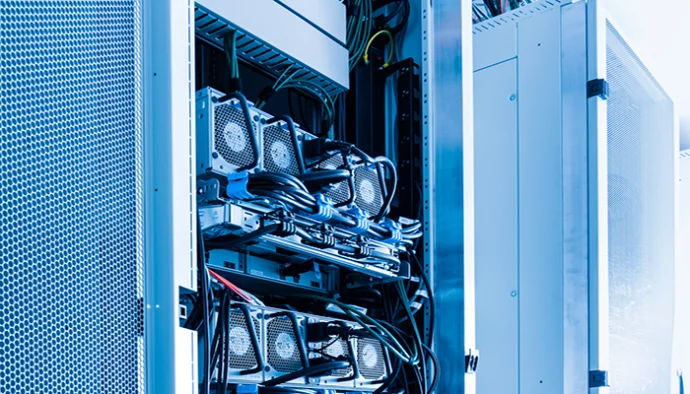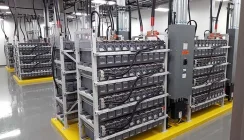How Data Centre Uninterruptible Power Supplies Improve Operational Energy Efficiency and Reliability
IData centres are at the core of the critical IT infrastructure the we use everyday. These facilities operate 24/7 to provide uninterrupted services, making power reliability a top priority. Among the critical systems in a data centre, Uninterruptible Power Supplies (UPSs) stand out as essential components, protecting IT loads from power interruptions, surges, and outages. Over the years, UPS technology has evolved significantly, becoming more energy-efficient and reliable, helping operators reduce operational costs and ensure the uptime of critical power paths.
This article explores how UPS technology has evolved, the role these improvements play in reducing energy consumption, and how modern UPS systems contribute to data centre uptime and sustainability.
The Role of UPS in Data Centres
A UPS serves as the first line of defence in the critical power path, providing immediate backup power when utility supply is interrupted. It ensures a seamless transition to backup generators and protects IT equipment from voltage sags, surges, or harmonic distortions that could damage hardware or disrupt operations. UPS systems also store energy, typically in batteries, to supply temporary power during short outages or until generators are activated.
The dual role of protecting uptime and mitigating energy losses means UPSs must be both reliable and efficient. As data centres grow in size and power demand, traditional UPS systems, once a significant source of energy waste, have undergone transformative changes to meet the evolving needs of operators.
Evolution of UPS Technology: A Journey Towards Efficiency and Reliability
The first uninterruptible power supply was developed (and later patented) in 1934 by John J Hanley for use with emergency lighting. The modern UPS system started to appear decades later as computing was developed and deployed within industries including the oil industry. UPS developments are driven by a need to make them as energy efficient and reliable and this has lead to a wider adoption of modular UPS in data centres in the last 10 years and UPS manufacturers developing larger kVA and MVA sized systems to support the power demands from newer technologies including artificial intelligence (AI).
See: https://patents.google.com/patent/US1953602A/en
Transition from Legacy to Modern UPS Systems
Older UPS systems, such as offline or line-interactive models, were suitable for small-scale applications but inefficient and unreliable for large, high-density data centres. These legacy systems often operated at lower efficiencies (around 85-90%) and provided limited power conditioning capabilities.
Modern UPS systems, particularly online double-conversion designs, offer near-perfect power protection by isolating the IT load from the utility supply. While early double-conversion systems introduced efficiency losses during conversion processes, advancements in semiconductor technology and design have improved efficiency to 96-98%, dramatically reducing energy waste.
Introduction of Modular UPS Designs
One of the most significant innovations in UPS technology is the development of modular UPS systems. Unlike traditional monolithic UPS units, which require large upfront sizing and capacity planning, modular designs allow operators to scale power capacity incrementally by adding modules.
The Benefits of Modular UPS Systems
Modular UPS systems are now one of the most popular types deployed in data centres. They offer several advantages over traditional monobloc designs:
- Improved Efficiency at Partial Loads: Traditional UPS systems often operate at low loads, where efficiency drops significantly. Modular systems enable right-sizing, ensuring that the UPS operates closer to its optimal efficiency point.
- Redundancy Without Overprovisioning: Operators can configure redundancy (e.g., N+1 or N+X) without deploying oversized systems, reducing capital and energy costs.
- Easier Maintenance and Repairs: Faulty modules can be replaced without shutting down the entire system, improving uptime.
Advances in Energy Storage
The energy storage components of a UPS, typically batteries, have also evolved, with innovations that enhance efficiency, reliability, and sustainability.
Lithium-Ion Batteries (Li-ion)
- Li-ion batteries are increasingly replacing traditional lead-acid batteries due to their longer lifespan, higher energy density, and faster recharge times.
- They reduce total cost of ownership (TCO) by minimizing battery replacement and maintenance costs.
- Li-ion technology also improves UPS reliability, as their performance is more predictable under varying loads.
Flywheel Energy Storage
Flywheels store kinetic energy to provide short-term backup power, eliminating the need for batteries in certain configurations. They are highly reliable, require minimal maintenance, and are ideal for bridging power gaps during generator startup.
High-Efficiency Operating Modes
Modern UPS systems incorporate intelligent operating modes that dynamically adjust to load conditions, further improving efficiency.
- Eco Mode: In eco mode, the UPS bypasses its double-conversion process during stable power conditions, directly supplying utility power to the IT load. This improves efficiency to as high as 99%. The system instantly switches to double-conversion mode during power anomalies, balancing energy savings with reliability.
- Dynamic Online Mode: Dynamic modes combine the reliability of double-conversion with the efficiency of eco mode by actively monitoring power quality and switching modes as needed without compromising protection.
Integration with Digital Monitoring and Management Tools
UPS systems are now equipped with smart monitoring and control capabilities, leveraging IoT and cloud-based platforms to optimize performance.
- Real-Time Monitoring: Advanced UPS systems provide real-time insights into energy usage, load levels, battery health, and system efficiency. Operators can use this data to proactively address potential issues, reducing the risk of downtime.
- Predictive Maintenance: UPS systems use machine learning and AI algorithms to predict component failures, enabling preventive maintenance. This enhances system reliability and extends equipment lifespan.
- Energy Optimisation: Digital platforms integrate UPS data into the broader data centre infrastructure management (DCIM) system, enabling holistic energy optimization across power and cooling systems.
Benefits of Modern UPS Systems for Data Centres
Energy efficiency has always been important in data centre environments and has continued to hold a key position in reporting metrics for many organisations. Modern UPS designs can help to reduce overall energy usage and improve several other factors.
Energy Efficiency and Cost Savings
Energy efficiency improvements in modern UPS systems have a direct impact on reducing operational expenses:
- Reduced Power Losses: High-efficiency UPS systems minimize energy waste during power conversion, lowering utility bills. For large data centres, even a 1% improvement in efficiency can translate to significant annual savings.
- Lower Cooling Requirements: More efficient UPSs generate less heat, reducing the burden on cooling systems and further lowering energy costs.
- Sustainability Goals: Improved efficiency aligns with sustainability initiatives, helping operators reduce their carbon footprint and meet regulatory requirements for energy consumption.
Enhanced Reliability and Uptime
UPS advancements ensure uninterrupted power delivery and better protection for critical IT loads:
- Faster Response Times: Modern UPS systems provide near-instantaneous backup power during outages, eliminating disruptions and protecting sensitive equipment from data loss or corruption.
- Fault Tolerance: Modular designs and advanced diagnostics enhance fault tolerance, ensuring uptime even if individual modules fail.
- Seamless Integration with Generators: Intelligent UPS systems facilitate smooth transitions to backup generators, reducing the risk of load drops during power switches.
Scalability for Future Growth
As data centres expand, scalable UPS solutions enable operators to meet increasing power demands without overhauling infrastructure. Modular designs allow capacity to grow incrementally, avoiding unnecessary capital expenditures and optimizing resource use.
Best Practices for Deploying Energy-Efficient UPS Systems
To maximize the benefits of modern UPS technology, data centre operators should adopt the following best practices:
- Right-Size the UPS: Choose UPS systems that align with current and projected power requirements to avoid overprovisioning and underutilization.
- Leverage Modular Designs: Implement modular UPS systems to scale capacity efficiently and improve redundancy.
- Implement Eco Mode Strategically: Use eco mode where power quality is stable, balancing energy savings with protection needs.
- Monitor and Maintain Batteries: Regularly inspect and test batteries or consider transitioning to lithium-ion technology for greater reliability and longevity.
- Integrate UPS Monitoring Tools: Deploy intelligent monitoring platforms to track performance, energy consumption, and system health in real-time.
- Conduct Regular Maintenance: Schedule preventive maintenance and load testing to ensure UPS reliability and readiness for emergencies.
Summary
Modern UPS systems have come a long way from their early iterations, offering unprecedented levels of energy efficiency and reliability. These advancements empower data centre operators to reduce energy costs, lower their environmental impact, and maintain the uptime required to support critical IT infrastructure.
As data centres continue to grow and evolve, the role of UPS technology will remain central to protecting the critical power path. By investing in energy-efficient, reliable UPS solutions and adopting best practices for deployment and maintenance, operators can build resilient power systems that meet both operational and sustainability goals.
For more information on our data centre uninterruptible power supplies and we can help to deploy the right UPS system from Borri, Eaton, Legrand, Riello, Schneider or Vertiv for your data centre, please contact our Projects Team.


























